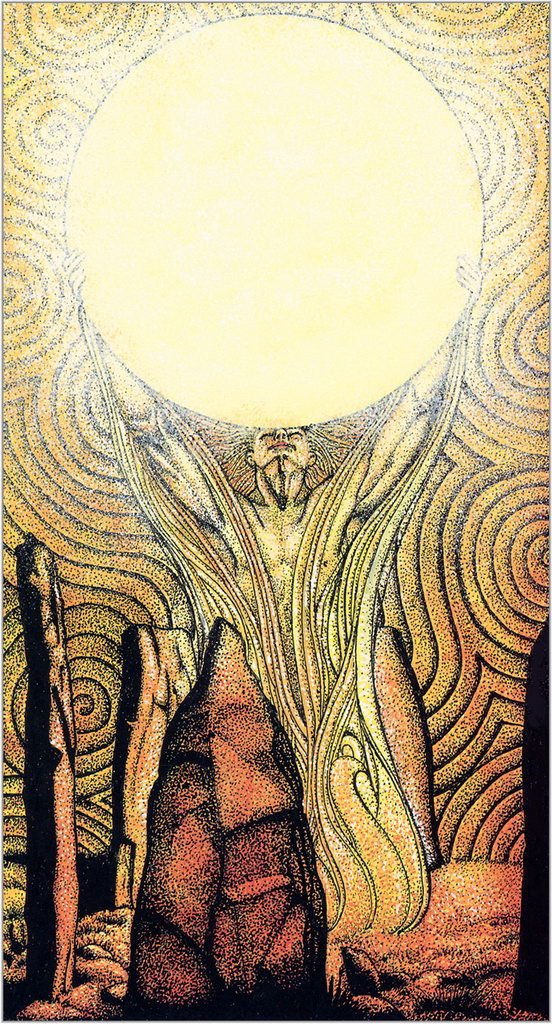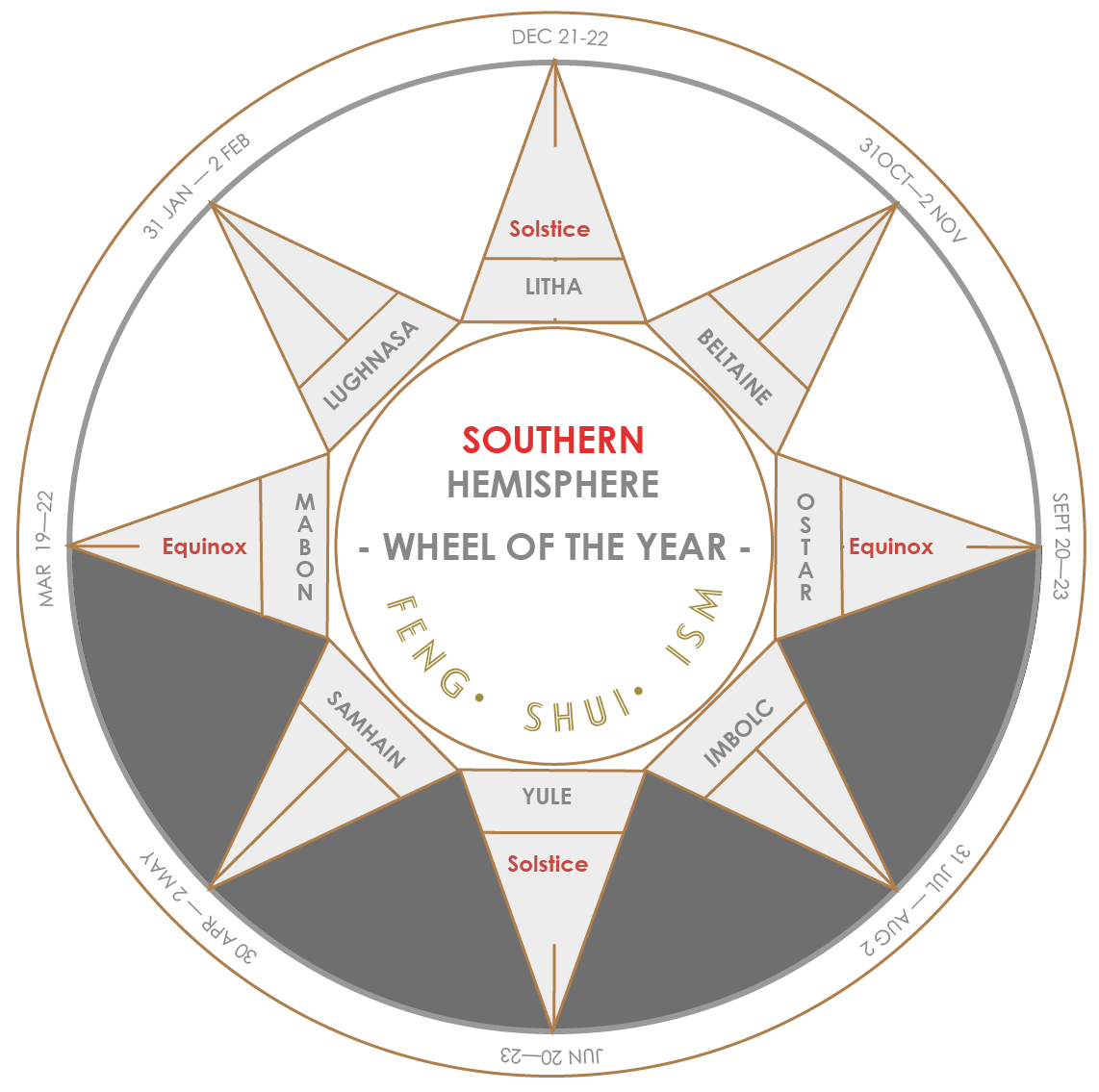It's time to celebrate the Polarity of Seasons again. Phenologists will appreciate, when the dog days of summer bring balmy humidity, I know my internal barometer is in sync with seasons! The dog days of Summer coupled with the end July (or Jan in S.H), are both calendar and celestial indicators; a midpoint point between Solstice and the next Equinox and the heliacal rising of Sirius the Dog star. This crucial time on the Celtic Wheel of the Year is a time of Harvesting nature’s bounty, known as Lughnasadh, an Autumnal festival marker.
Honouring Tradition
Traditional Celtic festivals are pivotal seasonal points in the Celts calendar, marking a time to reflect on the season past and what the future season will hold. Of course they represent a time of year — and not just a singular date — with seasonal fairs celebrating calendrical points in time. Celebrated at sacred places, landmarks, temples or megalithic structures, they often also heralded an astronomical event, bringing attention to the two main luminaries in the sky - sun and moon. The four cardinal points of year marked by pairs of Solstices and Equinoxes, combine with the four cross quarter divisions to create the eight solar divisions - *Imbolc (31 Jan-2 Feb.), Beltaine (30 April-2 May), Lughnasa (31 July - 2 Aug.) and Samhain (31 Oct -2 Nov.). In fact the origins of the Pagan calendar are believed to be lunar but appeared to have adopted the solar calendar around the time of Christianity, when Christian traditions celebrate Candlemans (Imbolc), May Day Virgin Mary (Beltaine), Lammas (Lughnasa), and All Saints Day (Samhain) And Yule as Christmas, arguably the most Christianised of them all.
It helps to tune into the actual Seasonal ingress before you — as well as Equinoxes and Solstices — rather than getting hooked on calendar month/dates, as it causes confusion with the Southern Hemispheres’ eight seasonal markers which are flipped. For example, as I write in the Northern Hemisphere the old fire festival of Imbolc is unfolding from sunset 31 Jan - sunset on 2 Feb*. But in the Southern Hemisphere, the opposing marker of Lughnasadh unfurls as many in Pagan, Wiccan, Druids and Celtic advocate marking the first Harvest time in the Lands DownUnder. More details on Imbolc customs via our Spring post here.
Lughnassadh :: Autumn (N.H 31 Jul - 2 Aug ↔︎ S.H 31 Jan - 2 Feb)
It’s the solar mid point between Summer Solstice and Autumn Equinox that signals Lughnasa. This Fire festival marker celebrates the first harvest of ripe grains specifically and the threashing of grain with a Scythe. Lughnasadh is believed to be named after the Celtic God of Light (Lugh), said to be a son of the Sun and foster son of Tautia, the telluric Goddess of Fertility. Lugh is also thought to be father of the Irish legend Cuchulain. Titled a patron of the arts and master craftsman such as forging and smithing swords (like Goddess Brigid, honoured as christianised version on St. Brigid Day On 1st Feb, near at the opposing marker of Imbolc). Lugh is oft depicted with a ‘Sword of Light’ or spear (sleg of Assal) in his hand, as a noble warrior in famous Battles. The crow/raven is also associated with omens and the Sun God Lugh; lugos means Raven and for me draws as parallel with the Sun crow in Chinese mythology. Some historians note that Lugh is in fact the equivalent of Roman God Mercury (Hermes). Others see him aligned to a God of three faces, the triple function, trefoil another adapted Christian parable - aka the Holy Trinity. Lúnasa is also the Gaelic calendar name for the month of August.
Like all Celtic Festivals sunset marks the beginning of a new day so Lughnasadh celebrations commence on 31 July and finish at sunset on 2 Aug.* by the Pagan/Wiccan fraternity. According to folklorist Máire MacNeill, an offering of the 'first fruits', a feast of the new food and of bilberries, the sacrifice of a bull and a ritual dance-play in which Lugh saves the harvest for mankind, by defeating the powers of blight. The killing and quartering of a white mare was sacrifice for the rise of ‘New King’ (waning King) of the Solar year. Some folklore denotes Lugh initiated Lughnasadh festival to honour the death of his adoptive mother Taultic, who was revered for her land mastery. So in essence this festival also carries Funeral rituals - endings - a time of the shadow. The sun sets in the West, and where Sol is said to die.
Like all festival markers it involved gatherings that included ceremonies, rituals, feasts, matchmaking, trading, visits to holy wells; and Fires. Be it bonfires, embers, flaming wheels etc there’s two theories as to the purpose of Fire - as Sun rituals or Purification, both carry weight. In my opinion it’s a blend of both.
A notable tradition still continues today - the custom of climbing hills and mountains at Lughnasadh. Although religious in nature, the 1,500 years of Christian pilgrimage known as 'Reek or Garland Sunday' is when folks climb the top of a mountain in Ireland called ‘Croagh Patrick’ on the last Sunday in July. On top of the mountain itself, is evidence of a sacred ritual site, which now houses a church where a former Christian oratory lay.
The rolling sun spectacle at Croagh Patrick
The mountain climb is immersed in Christian folklore, but roots of the act are in fact of Pagan significance and probably denoting an astronomical archaeology marker due to significant Rock art at the foothill of the mountain. A Westport local historian, Gerry Bracken back in 1991 noted the "rolling sun spectacle" down the side of Crogh Patrick. Six kilometers East from the foothill of Croagh Patrick a decorated stone marker in a farmland, acts as a vantage marker to watch Sol “roll” gradually and precisely following the edge of the mountain's silhouette down the right-hand slope of the mountain. August 24th is the best date for this vantage point. In my opinion this links to another Celtic God, Tarnis the God of storms and Thunder famed for his flaming wheel of Fire that rolls down a hill. In some Celtic lore Tarnis is also known as Tuireann, whose three sons were killed by the hand of the aforementioned Sun God Lugh — as a revenge killing and legal rite — against the slaying of Lugh own father. Tuireann subsequently died from grief. The ‘rolling sun’ is symbolic of endings, deaths, shadow time and a sacrifice to the land in lieu of fecund soil. A flaming wheel (spoked sun wheel ) offered smoke omens, if the smoke billowed towards grain fields, it signaled an abundant crop. Astro star lore also notes the heliacal rising of Sirius star when coupled with the Sun, forged great heat known as ‘dog days of summer’ and this pairing was seen as an omen that brings potential catastrophe, like drought, storms or thunder.
Marking Season
Festivals then and now, are celebrated with song and dance, although the dances and customary feasts were ritualistic in nature in times past. Whatever seasonal produce was in abundance graced the feast tables and sacred herb buds were gathered. At Lughnasadh, culinary custom of Bread dominates, due to grains bounty at this time of year. In christian circles the Pagan festival is now overshadowed by Lammas; loaf mass “Mass of the Loaves”.
Many know the Corn Mother/Corn Doll but it’s not unique to Ireland with Germany, Austria and other European countries following similar customs. Male and female effigies fashioned from corn sheaf’s are symbolically placed in barns till threshing is over and stand guardian over grain from mice. Grain wreaths are also fashioned and at various symbolic points in the year components from the effigy or the wreath are added to ceremonies. Harvest Grains from the Corn doll symoblises seed, and in turn incorporated into Spring’s Imbolc rituals etc. . . and at the next Festival marker when the last of the grain is harvested, a larger doll is fashioned and called the Cailleach (old maiden/wife). We see the Christian interpretation with Lammas and the bread analogy and the from the “Body Of Christ”…..
And if you’re lucky enough to be in the Emerald Isle (and reading in the month of February for Imbolc), then take a visit to Co. Meath. In Meath, a place called Tara has long been linked to the Ireland’s High Kings. The Neolithic Mound of the Hostages (Dumha na nGiall), an ancient passage tomb built 3350 and 2800BC is located in the Tara-Skryne Valley. The dome structure mound has a short passage that is aligned to cross-quarter days in November and February, corresponding to the rising Sun of Samhain and Imbolc. The aforementioned Croagh Patrick honours the setting sun in August for Lughnasa.
I can’t mention Lughnassadh without thinking of the amazing Irish playwright Brian Friel, who wrote a play called Dancing at Lughnasa. I was lucky enough to shoot and publish Friel’s home in Donegal many moons ago, so I’ve a soft spot for this work. The play has been adapted in to film staring Meryl Streep and perhaps worth a view to see some interpretations of fire festival traditions.
PURIFICATION + CROSS CULTURAL CUSTOMS
Since Fire Purification and cleansing is so closely linked to new beginnings and getting ready for the new season, it's an ideal time to spiritually cleanse and space clear your home or perhaps re arrange your furnishings - in accordance with Feng Shui. The opposing cross quarter festival marker — Imbolc — when celebrated in the Northern hemisphere falls in February and technically correlates to the beginning of the *Solar Chinese New Year (CYN). Like Chinese Cultural customs who favour and emphasis Midpoints the Celtic Cross Quarter festivals are midpoints between Solstices and Equinox which are solar observations. The ‘Spring Festival’ marker is the 1st solar marker of the year in the 24 Solar Terms system of correlating Seasonal nodes and the incremental adjustments throughout the year. In the main this date slightly fluctuates and it’s sols degree on the celestial equator that dictates the timing. If the degree occurs after 12 midnight, when a New Chinese day commences (in Rat hour) the the date shifts. Dates fluctuate between Feb 4-5 and sometimes 3 Feb.
Noting Lughnasa is also a cross quarter point therefore a midpoint, an astronomical marker between the Summer Solstice and Autumn Equinox, this is commonly observed/celebrated between (N.H 31 Jul - 2 Aug) in Pagan/Wiccan circles when Sabbaths are observed. But, 7 August (in N.H) is perhaps a truer astrological date as followed in Chinese Calendar system and exact midpoint of the year— between the beginning of Spring (Imbolc) and Lughnasa the first harvest of Autumn.
CNY prep is traditionally very focused on Spring cleaning, cleansing your home, removing last year’s energies and preparing for the incoming new year energies. You can find more info on our Space Clearing or Feng shui consultations to help you usher in the new season and capitalize on the prosperous energies of the year ⧇
* NOTES - The more well known beginning of the Chinese lunisolar Calendar is Lunar New Year (CLNY). The Chinese calendar follows Luna and Solar cycles - it’s a magical system with many calendrical calculation rules - one of which is the Winter Solstice (Dec) falling in the 11th Lunar Month, and then the Second New Moon after the Solstice indicates the beginning of a Chinese Lunar New Year, fluctuating due to Luna’s cycles. But the Solar New Year is more stable so when the Sun reaches the celestial longitude of 315° Li Chun aka ‘Spring begins’ and a New Solar Year. In the Gregorian Calendar (universal world calendar) this is normally between 4-5 Feb.
“Living eye to eye with ancient wisdom ”
— FENG SHUi iSM
















